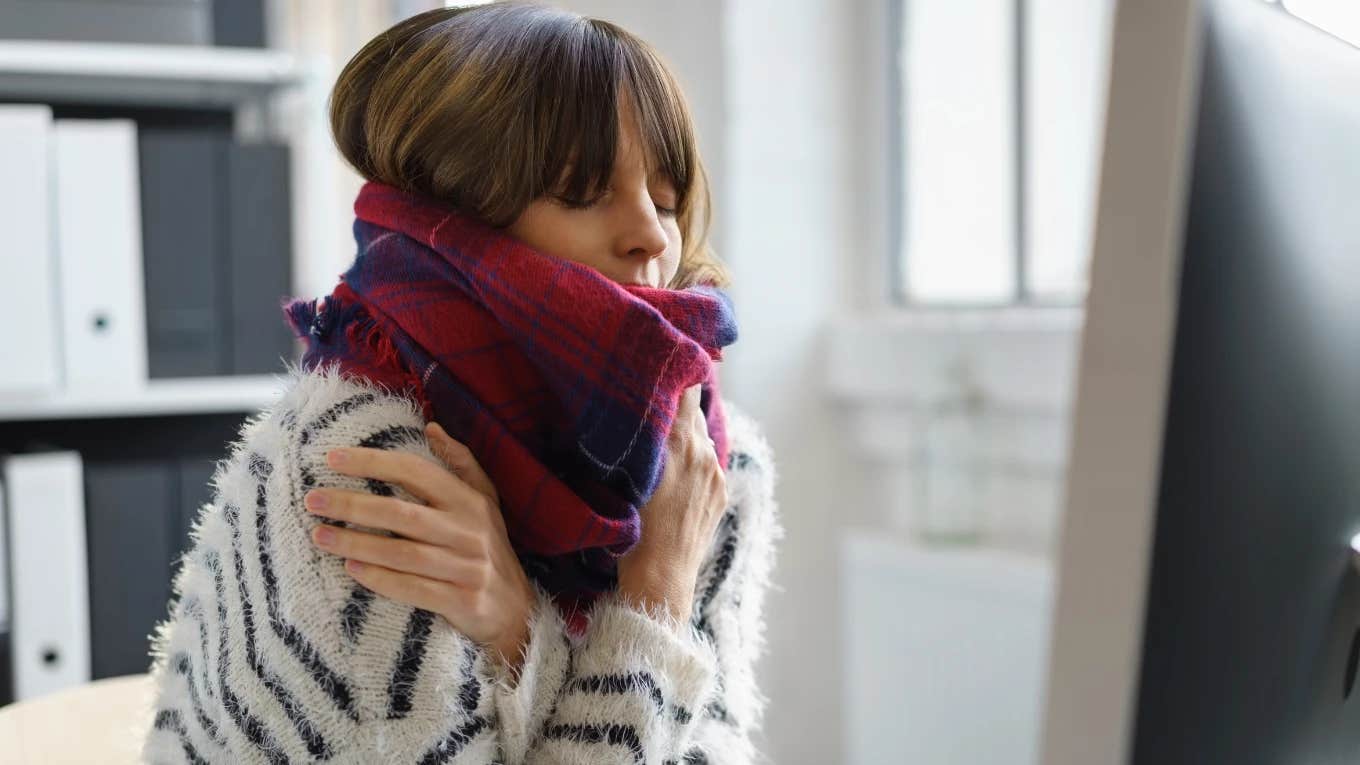Corporate Woman Exposes The Real Reason Many Office Buildings Are So Cold — ‘The Standard Was Set In 1966’
Gender biases are intertwined in even the most mundane of corporate decisions.
 stockfour / Shutterstock.com
stockfour / Shutterstock.com We've all heard stories about the gender pay gap, gender discrimination and harassment in the office, and even unfair gendered expectations for professional attire — but what about the temperature? Are you always cold at work, shivering in your cubicle, or reaching for a sweater on a hot summer day?
Content creator Sahar Khorram admitted she’s the first to complain about the temperature in her office but isn't ignorant to the reason why nothing seems to change.
A corporate woman revealed that the real reason why many office buildings are so cold is because the standard was set by men who were wearing suits.
“If you’re a corporate girly and in your office, you have to wear two sweaters, a blanket, and use a space heater when it’s 76 degrees outside, you’re not crazy,” she started in a recent video. “You’re not delusional, and chances are you’re not even anemic.”
She admitted that after complaining about her frigid corporate office for so long, she was met with a harsh reality — she wasn’t the employee they were worrying about pleasing.
“The reason why you’re so cold is because U.S. office buildings, specifically corporate buildings, are based on two factors,” she explained. “The metabolic rate of a person and what they’re wearing. That standard was set in 1966 on white men wearing suits.”
Although there’s a wide variety of workers with a wide variety of dress codes, nothing has changed — shocker!
Originally developed in 1966 based on a standard of “employee satisfaction,” the temperature expectation for corporate spaces was meant to appease as many people as possible while saving energy costs. Being that the standard employee in corporate spaces was older white men wearing suits, it made sense to cater the temperature to best suit them.
However, now that the corporate employee demographic has diversified, it no longer makes sense to maintain this standard. Not only are most employees not wearing suits, but the average metabolic rate is much different.
According to family physician Rob Danoff, women’s metabolic rate is much lower than men’s, meaning they produce less heat than men on average. Because of this, they’re much less comfortable in colder spaces than their male counterparts — impacting their productivity, comfort, and overall job satisfaction in many cases.
Despite research that suggests cooler corporate offices heighten the potential for errors, many employers still keep their spaces cold. So, is comfort more important than accuracy? Whose comfort are they truly looking out for? It’s clear that the historical standard is more influential than many might like to acknowledge.
From professional dress expectations to upward mobility opportunities, it’s impossible to separate gender from discussions of corporate workplace dynamics.
When women research business casual expectations for work, discussions of modesty and conservative clothing are the first things to pop up. For men, there’s no mention of covering your body, hiding your knees, or keeping your shoulders off display — only articles about well-fitted suits and neutral colors.
Despite discourse suggesting growing equality and equity, the gender pay gap is unsettlingly similar to what it was over 20 years ago — women make 84 cents for every dollar their male counterparts make for the same job. While every woman’s experience is unique, studies like this reveal that there’s still an overwhelming standard of gender discrimination thriving in the corporate world.
Of course, many women face this kind of discomfort in the workplace, especially those in toxic corporate spaces, but women of color face them at disproportionate rates. It’s a complex discussion of intersectionality — not only are these women carrying a perception of their gender in the workplace, but they’re also bringing their race, ethnicity, sexuality, and appearance.
Stereotypes and stigmas about gender, race, and sexuality inevitably play a role in the workplace, whether it’s unconscious biases for employee raises or obvious contributors to conversations between colleagues. More than 60% of black women have been affected by racial trauma in the workplace in the last year alone — this discussion is impossible to ignore.
So, yes — women feel cold in the workplace. It might seem like a silly joke to some or an unfortunate bonding experience for others, but the reality is that it’s the tip of the metaphorical corporate iceberg.
Women, especially POC and queer women, face hundreds of barriers at work that their cis-gender white male colleagues don’t, affecting their well-being, productivity, potential for growth, and identity.
Zayda Slabbekoorn is a News & Entertainment Writer at YourTango who focuses on health & wellness, social policy, and human interest stories.

